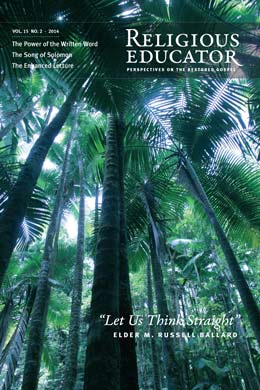Communication and Understanding
Editor's Note
In this edition of the Religious Educator, we are introducing a new section that will appear from time to time near the end of selected issues. That section, entitled “Notes,” will include short notes on historical, doctrinal, and pedagogical matters where the idea is too short for a full-length treatment but where the idea still warrants mentioning in print. We hope that these notes prove helpful to our readership.
This issue of the journal offers two timely articles on the challenges of communicating belief and intent in our day and age. The first, written by Elder Ballard, touches upon the timely subject of the eternal concept of gender while balancing that discussion with the tricky concept of gender equality. Elder Holland then touches upon the concept of writing and communicating clearly our innermost thoughts and intents. In discussing gender and equality in the public forum of ideas, there has been a great deal of acrimony and accusation, and Elder Holland reminds us of how difficult it can be to communicate clearly our beliefs and ideas in print and otherwise. He encourages us to write and rewrite and rewrite again until the quality of our prose matches the intensity of our belief. These two articles together offer a timely reminder that the discussion of gender and other topics would benefit if we all took the time to carefully present our ideas in thoughtful ways and to avoid hasty characterizations. Good writing takes work, and understanding takes additional work.
Finally, this issue offers several insightful articles on matters of doctrine and scripture. In this issue readers will benefit from contemplating one of the few articles by a Latter-day Saint author on the Song of Solomon and what that book might contain that would be of benefit to readers and teachers. Additionally, Joseph Spencer wrestles with the issue of grace versus works and how the original context of Nephi’s teaching, “for we know that it is by grace that we are saved, after all we can do” (2 Nephi 25:23), shapes the way we understand this verse. This issue of the journal presents many valuable insights, and the reader will benefit from reading carefully each article.
Thomas A. Wayment
Editor
